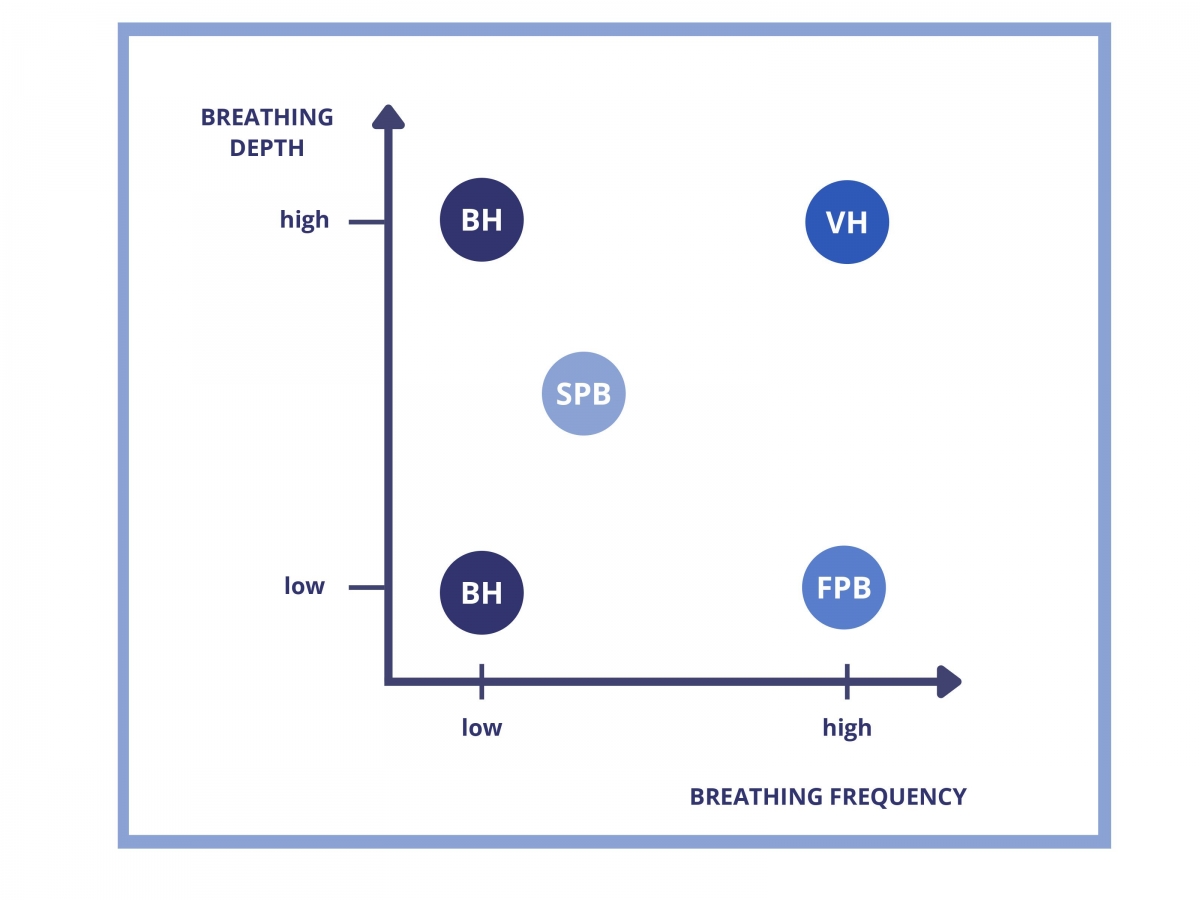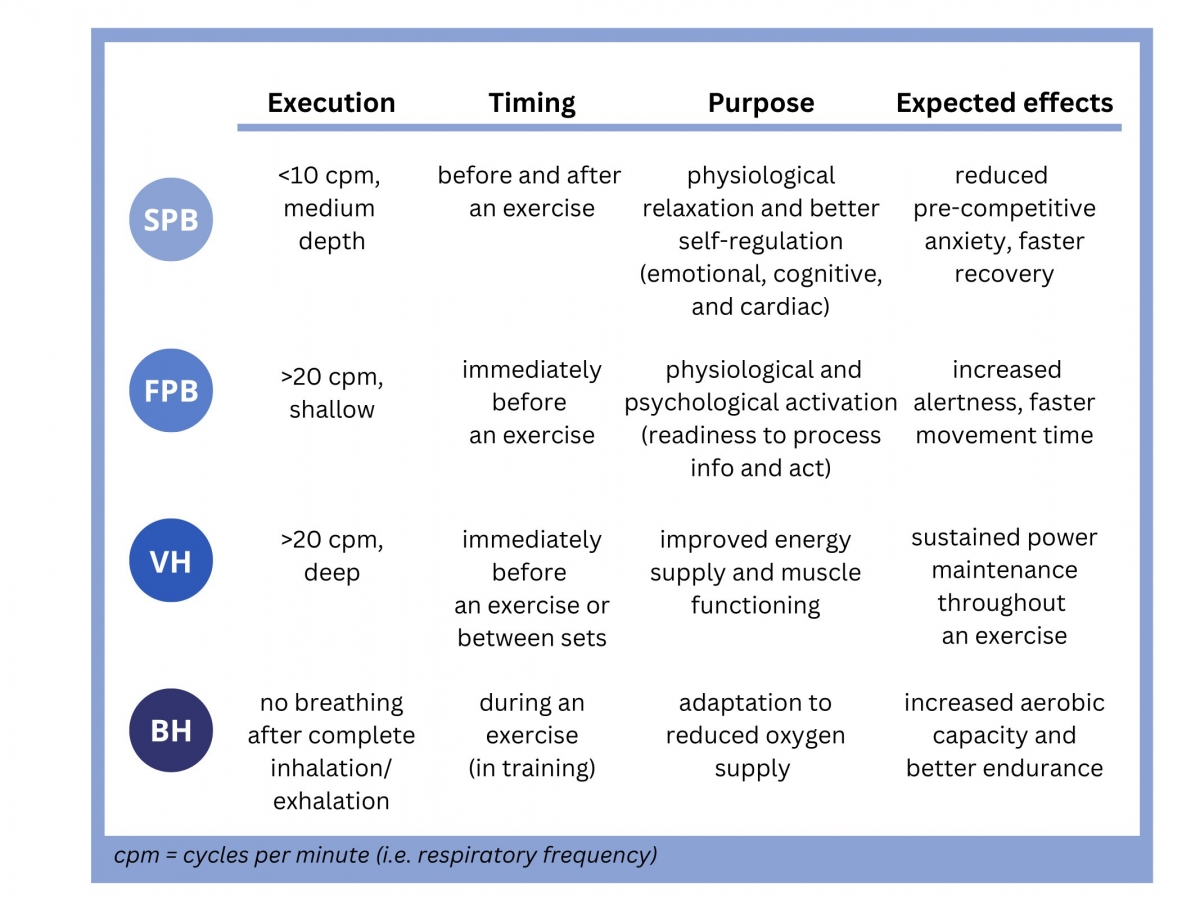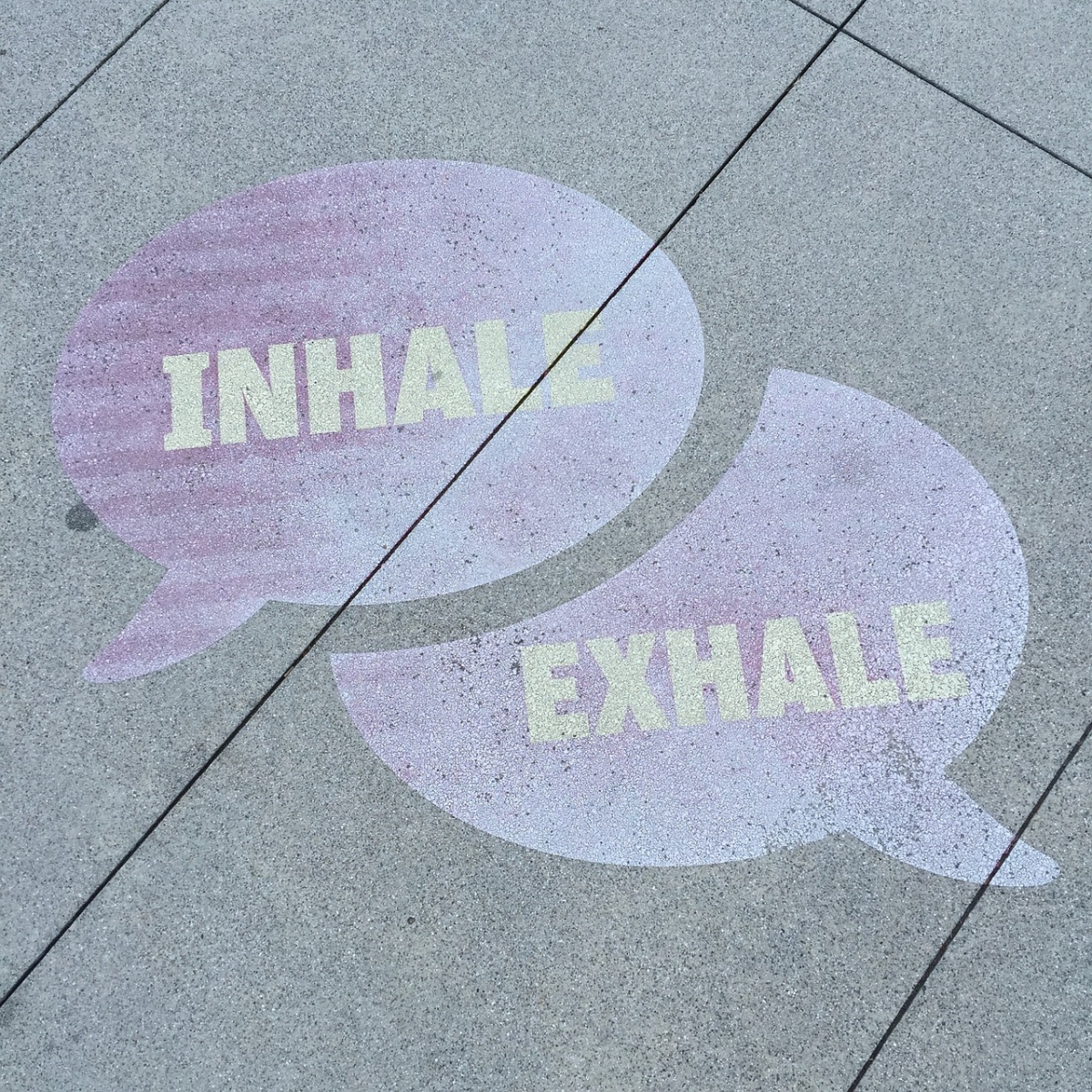Use your breath to gain a performance advantage
Editor: Elisa Bisagno
Editorial Assistant: Rinat Meerson, Sofia Calderon
This article has also been translated into German, French and Italian.
Inhale. Exhale. Inhale. Exhale. Are you mindful of your breathing pattern? In sports, having control over one’s own breathing pattern and its regulation represents a prominent advantage. The authors draw upon empirical findings, providing an overview of the science behind voluntary breath modification and its role in Olympic athletes’ performance.
Consider the example of Emma, a swimmer preparing for the upcoming Summer Olympics. To prepare her mind and body for the competition, she is creating a checklist to carefully plan her (pre-)performance routine. After ticking off multiple elements, her eyes stop at
arousal management. She had previously experienced
anxiety before the race, requiring relaxation techniques. However, she does not want to be too drowsy at the start and fall behind the competitors. How to address this dilemma and achieve the optimal activation of both body and mind? To answer this question, we propose voluntary breathing modification.
The origin and the four main techniques of voluntary breath modification
Breathing is essential for the survival of every human being. While the importance of breathing has been recognized across all epochs since ancient times, Eastern cultures are particularly well-known for developing breath-modifying techniques such as Pranayama, i.e., control of the life-currents through regulation of breath [1]. Nowadays Pranayama techniques can still be learned and performed through Yoga practice.
In the sports context, breathing techniques have evolved to meet specific demands. They are simpler than the classic Pranayama techniques and more adaptable to unpredictable contexts such as those found on a soccer field, a tennis court, an ice rink, and a swimming pool. Despite such modifications, breathing techniques can exert their benefits even when applied in the simplest way.
Breathing techniques applied in sports may be differentiated based on their breathing frequency and depth. The breathing frequency is measured in cycles per minute [cpm], composed of one full inhalation and one full exhalation. The four main techniques commonly applied in sports are slow- and fast-paced breathing, hyperventilation, and breath holding [2]. Slow-paced breathing (SPB) represents the breathing technique that has gained the highest interest in research and applied sports. It is performed at a frequency below 10 cpm, most commonly at 6 cpm, inhaling through the nose and exhaling through the mouth with pursed lips. It is also important to perform SPB abdominally, which means the stomach (rather than the chest) moves in and out.
Fast-paced breathing (FPB) in contrast dictates an increase in breathing frequency beyond the regular pace. This technique has been researched to a much lesser extent and a universally established protocol is yet to be developed. However, FPB is commonly performed at frequencies ranging from 25 to 60 cpm in novices and even faster frequencies (120 cpm or more) in expert Pranayama practitioners. FPB is performed by shallowly breathing in and out through the nose to take in small quantities of air and avoid hyperventilation. As in SPB, the breathing movement is driven by the abdomen.
Voluntary hyperventilation (VH) has been frequently referred to synonymously with FPB, with the crucial difference in the level of breathing depth. When performing VH practitioners breathe rapidly but additionally take in larger quantities of air than during FPB. This technique is applied cautiously, and the hyperventilation state is mild and extremely short-lived as will be explained later in more detail.
Lastly, breath holding (BH), as the word itself suggests, involves periods during which the practitioner does not breathe in or out, which are called apneas. Apneas can be performed after a complete inhalation or exhalation.
 Image 2. Voluntary breath regulation techniques according to the breathing frequency and depth
Image 2. Voluntary breath regulation techniques according to the breathing frequency and depth
The physiological and psychological effects of breathing techniques
Broadly speaking, breathing techniques may be categorized into those that aim to induce psychophysiological relaxation or activation. On the physiological level, voluntary breath modification elicits changes in the autonomic nervous system activity. This system is divided into the parasympathetic and sympathetic branches, commonly known by the phrases “rest and digest” and “fight or flight”. While increased activity in the parasympathetic branch reflects relaxation, higher activity in the sympathetic branch signals activation. In addition to the autonomic nervous system, breathing also modulates brain activity, influencing cognitive, emotional, and sensorimotor processes [3]. Together, these psychophysiological changes have been proposed to underlie the performance-facilitative effects of individual techniques.
 Image 3. Voluntary breath regulation techniques according to the primary autonomic regulation mechanism
Image 3. Voluntary breath regulation techniques according to the primary autonomic regulation mechanism
Upon learning how each technique is correctly performed, the next step towards the effective use of modified breathing in sports performance is a comprehensive understanding of the specific effects each technique exerts on the body and mind. SPB has been shown to increase parasympathetic activity via the activation of the vagus nerve, leading to psychophysiological relaxation. This effect can be accentuated by prolonging the exhalation phase and thereby benefiting from the natural decrease in heart rate that occurs when we breathe out. At the theoretical level, SPB is proposed to influence the bidirectional link between the brain and heart, in line with the neurovisceral integration model [4, 5]. By activating the central autonomic network in the brain and increasing the vagally-mediated heart rate variability, an index of parasympathetic activity, SPB is suggested to improve self-regulation at emotional, cognitive, and cardiac levels. Enhanced self-regulation may help athletes to counter the debilitative symptoms of pre-competitive anxiety, such as high parasympathetic withdrawal and negative emotions. On a cognitive level, improvement was found in attention, inhibition, working memory, and flexible thinking (e.g., [6, 7]).
On the other hand, the activating effects of FPB and VH have been attributed to increased sympathetic and decreased parasympathetic activity. Experiencing a “fight or flight” response, an individual may for instance notice an increase in their heart rate and amount of oxygen used by the body. This physiological change enhances the creation and supply of energy, improving muscle functioning, particularly in fast-twitch muscle fibers. Additionally, during VH blood pH is increased, causing blood vessel narrowing, and reducing our urge to breathe. Despite the similarities, subjective perceptions of these two techniques may differ. While feeling energized and alert was common after FPB, prolonged hyperventilation was accompanied by panic and restlessness [8, 9]. Due to these sensations, the term “hyperventilation” is often negatively perceived. Contrary to anxiety-induced hyperventilation, during VH, individuals exercise intentional control over their breathing pattern. Nevertheless, specific populations such as panic disorder patients experience significantly more negative sensations during VH than healthy controls, despite similar physiological responses [10]. This finding has been attributed to misinterpretation of the bodily signals as anxiety at the cognitive level, suggesting caution in implementing VH in athletes suffering from panic and anxiety disorders.
Interestingly, BH elicits parasympathetic and sympathetic co-activation, increasing activity in both branches. Contrary to hyperventilation, blood pH is decreased during breath holding, causing blood vessel widening. Other changes in the body include reduced heart rate and redistribution of blood flow to preserve the function of crucial organs such as the brain when facing oxygen deficit [9, 11]. In sports, BH is often paired with water immersion, therefore it is also relevant to note that cold water further potentiates the co-activation of both branches.
Due to these distinct effects, each technique has to be purposefully implemented to facilitate rather than impede sports performance. The following section presents when athletes should apply specific breathing techniques, using examples from Olympic disciplines.
Implementation of modified breathing in (Olympic) sports
The practical implementation possibilities of the introduced techniques differ across sports disciplines due to the variety of cognitive and motor demands placed on the athletes (see [2]). Sprinters in the 100-meter race may benefit most from quick activation, while a more diverse set of breathing techniques should be adapted by marathon runners to address various stages of the event. Additionally, breathing may be modified not only during the sports performance but also before and after the main event.
Due to the overarching relaxation effect of SPB, this technique has been used in a variety of sports disciplines, as well as in everyday life. The benefits of regularly practicing SPB have been shown in subsequent performances in basketball, dancing, running, swimming, and cycling. The potential of this technique lies in its regular practice, enabling physiological adaptations to occur. For an optimal incorporation of SPB into practice, athletes may perform this technique before or after training sessions. Moreover, SPB can become an essential technique to counter pre-competition anxiety or stress. Athletes may also benefit from the relaxation effects post-competition or training to mentally and physically recover. It is not recommended to perform SPB during sports execution, as if it is not trained correctly, it may lead to breathing discomfort and performance declines.
The activating effect of FBP makes it an optimal technique to be implemented immediately before a bout of short, intense exercise in which athletes require maximal strength or need to be highly alert. For example, shot-put throwers may implement this technique before their maximum strength on the field is required. Furthermore, this technique can be practiced in everyday life to benefit from its general activating and abdominal strengthening effects. Thus, FPB can also be integrated into a morning routine to be focused and optimally activated for subsequent sports practice.
The increase in blood pH achieved through VH makes this technique an optimal strategy for enabling fast recovery between intense sprints. A runner performing sprint sets as part of a training session may therefore perform 20-30 seconds of VH during the recovery phase to enable faster recovery for the next set. In cycling, VH performed for 30 seconds prior to each sprint set has been shown to support sustained power maintenance throughout the entire exercise [12]. Due to increased body sway caused by performing this technique, it is not recommended to implement it during sports requiring balance. As physiological changes occurring during VH may be misinterpreted as anxiety, positively framing this breathing technique during instructions and giving a detailed explanation of the expected effects is particularly important.
BH induces physiological benefits similar to those elicited when training at high altitudes due to the restricted oxygen intake. Therefore, it may offer a time- and cost-effective alternative when such physiological adaptations are advantageous for performance, for instance in long-distance runners. Additionally, breath holds of varying lengths are commonly implemented during swimming training, as phases of BH are tightly coupled with movement execution. Long-term interventions with BH are required for physiological benefits and can be incorporated into many training programs across disciplines. For instance, a 2-week dynamic BH training (i.e., BH while swimming) led to faster freestyle and underwater swimming, with the reduction of heart rate proposed as the underlying mechanism [13]. Performing BH during competitive performance (other than swimming/diving) is not recommended, as the reduced oxygen supply to muscles may impede performance.
 Image 4. Characteristics of the four main techniques of voluntary breath regulation
Image 4. Characteristics of the four main techniques of voluntary breath regulation
Case in focus: A toolbox of modified breathing in Olympic and Paralympic swimming
The use of a single breathing technique may offer a competitive advantage when implemented in the appropriate context. Using a set of breathing techniques may nevertheless be even more powerful as the athlete can flexibly adjust their breathing according to varying task demands and individual needs. In the selected case in focus, we refer back to our swimmer Emma and draw on the experience of Olympic and Paralympic swimmers regarding their use of modified breathing in performance contexts [14]. Overall, swimmers have reported using several breathing techniques for performance enhancement and emotion regulation. The purposeful selection of the technique based on the momentary needs was evident in distinct time points of the implementation: “During the warm-up I used slow breathing. But right before the announcement, I started doing faster breathing” [14, p. 3573]. Additionally, breath holding and movement-synced breathing have been used during the swimming race to support the rhythmic strokes. In front crawl, for instance, swimmers may couple inhalation with body rotations and alternate between breaths to the left and right side of the body to maintain balance.
 Image 5. Implementation of breathing techniques throughout a swimming event
Image 5. Implementation of breathing techniques throughout a swimming event
What about the recovery period? None of the swimmers reported using SPB after the performance despite its potential as a recovery technique. Interestingly, some swimmers reported not using breathing techniques due to a lack of knowledge on how to effectively perform them. This finding highlights the importance of providing structured and easily-accessible recommendations on how to implement breathing techniques into athletic routines.
Recommendations for the use of modified breathing
Implementing breathing in sports is not a one-size-fits-all solution. In general, it is recommended to undergo a familiarization session when considering implementing these techniques, as they may potentially lead to breathing discomfort and adverse effects if performed incorrectly. Moreover, these techniques should be first implemented in practice sessions to honor the rule " Don't do anything new at a competition" [15, p. 226]. Several breath pacer apps can also be found on the market, which provide feasible guidance for performing such techniques. However, to ensure the correct execution of breathing techniques and monitoring of the effects, we recommend reaching out to a specialist.
In conclusion, the
power of voluntary breath modification lies in its flexible and timely implementation. Elite athletes may attain a competitive advantage by considering a range of breathing techniques and matching their effects to specific needs across training and competitive situations. In addition to improving physical performance, the described breathing techniques show potential as tools to attain psychological benefits, such as increased alertness, energizing effects, reduced maladaptive pre-performance
anxiety, and enhanced
working memory.
Bibliography
[1] Sivananda, Practical lessons in yoga, 8th ed. Sivanandanagar: Divine Life Society, 1997.
[2] S. Laborde et al., “The influence of breathing techniques on physical sport performance: a systematic review and meta-analysis,” International Review of Sport and Exercise Psychology, pp. 1–56, Nov. 2022, doi: https://doi.org/10.1080/1750984x.2022.2145573.
[3] D. H. Heck et al., “Breathing as a Fundamental Rhythm of Brain Function,” Frontiers in Neural Circuits, vol. 10, Jan. 2017, doi: https://doi.org/10.3389/fncir.2016.00115.
[4] C. Sevoz-Couche and S. Laborde, “Heart rate variability and slow-paced breathing: when coherence meets resonance,”
Neuroscience & Biobehavioral Reviews, vol. 135, p. 104576, Apr. 2022, doi: https://doi.org/10.1016/j.neubiorev.2022.104576.
[5] R. Smith, J. F. Thayer, S. S. Khalsa, and R. D. Lane, “The hierarchical basis of neurovisceral integration,”
Neuroscience & Biobehavioral Reviews, vol. 75, pp. 274–296, Apr. 2017, doi: https://doi.org/10.1016/j.neubiorev.2017.02.003.
[6] S. Laborde, T. Lentes, T. J. Hosang, U. Borges, E. Mosley, and F. Dosseville, “Influence of Slow-Paced Breathing on Inhibition After Physical Exertion,” Frontiers in Psychology, vol. 10, Aug. 2019, doi: https://doi.org/10.3389/fpsyg.2019.01923.
[7] M. Paul and K. Garg, “The Effect of Heart Rate Variability Biofeedback on Performance Psychology of Basketball Players,” Applied Psychophysiology and Biofeedback, vol. 37, no. 2, pp. 131–144, Mar. 2012, doi: https://doi.org/10.1007/s10484-012-9185-2.
[8] S. Balters, E. L. Murnane, J. A. Landay, and P. E. Paredes, “Breath Booster!: Exploring In-Car, Fast-Paced Breathing Interventions to Enhance Driver
Arousal State,” in Proceedings of the 12th EAI International Conference on Pervasive Computing Technologies for Healthcare, New York NY USA: ACM, May 2018, pp. 128–137. doi: https://doi.org/10.1145/3240925.3240939.
[9] C. Gilbert, “Hyperventilation and the body,” Accident and Emergency Nursing, vol. 7, no. 3, pp. 130–140, Jul. 1999, doi: https://doi.org/10.1016/s0965-2302(99)80072-1.
[10] E. Wollburg, A. E. Meuret, A. Conrad, W. T. Roth, and S. Kim, “Psychophysiological reactions to two levels of voluntary hyperventilation in panic disorder,” Journal of
Anxiety Disorders, vol. 22, no. 5, pp. 886–898, Jun. 2008, doi: https://doi.org/10.1016/j.janxdis.2007.09.004.
[11] L. Eichhorn et al., “Influence of Apnea-induced Hypoxia on Catecholamine Release and Cardiovascular Dynamics,” International Journal of Sports Medicine, vol. 38, no. 02, pp. 85–91, Jul. 2016, doi: https://doi.org/10.1055/s-0042-107351.
[12] A. Sakamoto, H. Naito, and C.-M. Chow, “Hyperventilation as a Strategy for Improved Repeated Sprint Performance,” Journal of Strength and Conditioning Research, vol. 28, no. 4, pp. 1119–1126, Apr. 2014, doi: https://doi.org/10.1519/jsc.0b013e3182a1fe5c.
[13] E. R. Mulder, P. K. Holmström, and E. K. Schagatay, “Effects of dynamic apnea training on diving bradycardia and short distance swimming performance,” J Sports Med Phys Fitness, vol. 62, no. 8, Jul. 2022, doi: https://doi.org/10.23736/s0022-4707.21.12549-6.
[14] S. V. Saint-Martin, M. J. Turner, and M. C. Ruiz, “Mental preparation of olympic and paralympic swimmers: performance-related cognitions and emotions, and the techniques used to manage them,” Journal of Physical Education and Sport, vol. 20, no. 06, Dec. 2020, doi: https://doi.org/10.7752/jpes.2020.06481.
[15] S. A. Riewald and S. A. Rodeo, Science of Swimming Faster. Human Kinetics, 2015.
[16] E. E. Benarroch, “The central autonomic network: functional organization, dysfunction, and perspective,” Mayo Clin Proc, vol. 68, no. 10, pp. 988–1001, Oct. 1993, doi: https://doi.org/10.1016/s0025-6196(12)62272-1.
[17] S. Laborde et al., “Leveraging Vagally Mediated Heart Rate Variability as an Actionable, Noninvasive Biomarker for
Self-Regulation: Assessment,
Intervention, and Evaluation,” Policy insights from the behavioral and brain sciences, vol. 10, no. 2, pp. 212–220, Oct. 2023, doi: https://doi.org/10.1177/23727322231196789.
Images
Image 1: kathleenport via Pixabay: https://pixabay.com/photos/street-art-breathe-inhale-exhale-2720456/
Images 2-5: self-created and property of the authors of the article.




